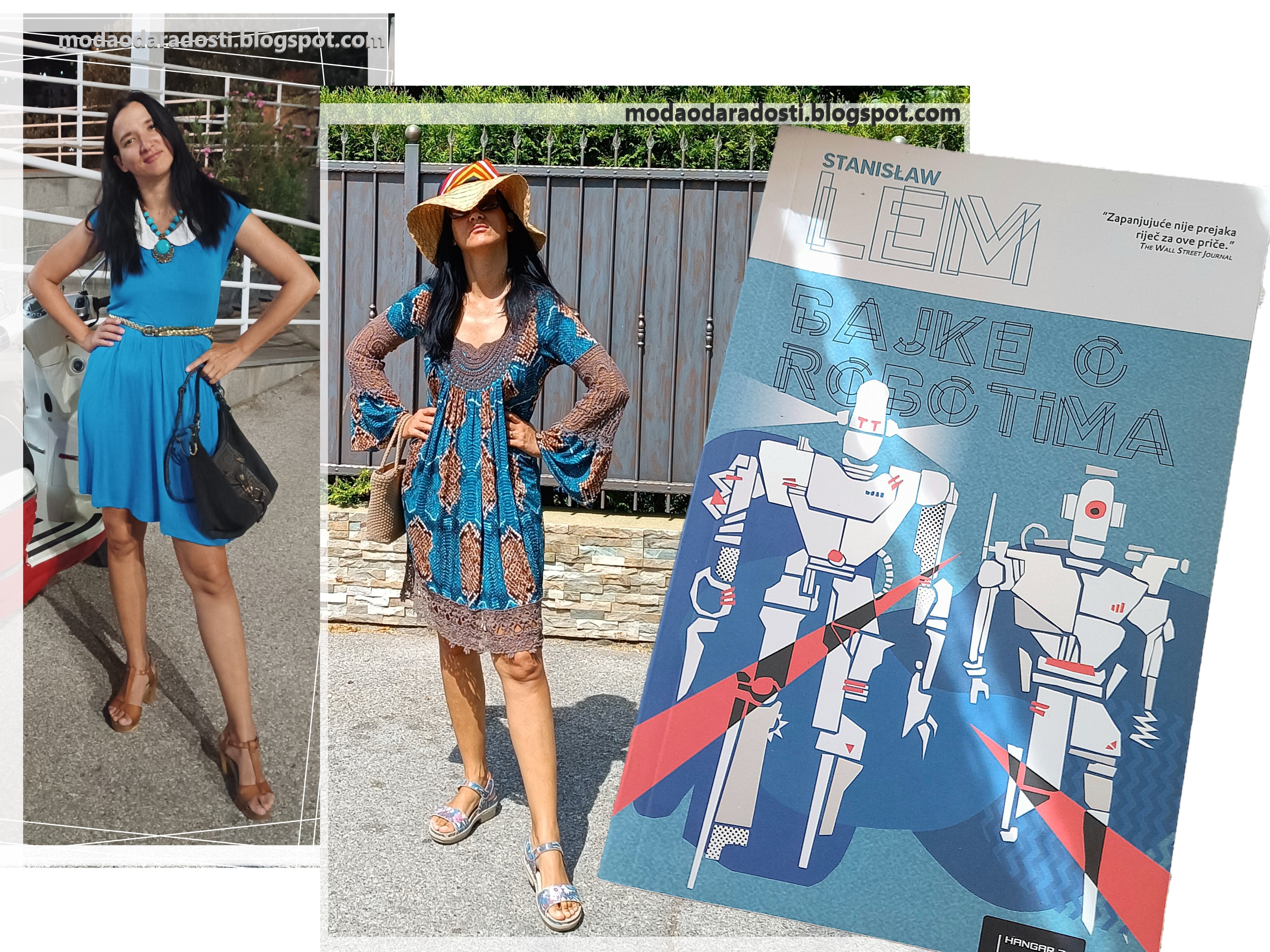FABLES FOR ROBOTS BY STANISLAW LEM (BOOK REVIEW AND OUTFIT POST)
MORE WORKS BY STANISLAW LEM WORTH READING:
The Magellanic Cloud by Stanislaw Lem was a 5/5 novel for me. Its original title (in Polish) is Obłok Magellana. The title of the book refers to dwarf galaxies orbiting the Milky way galaxy. As the title would imply, this book is about space travel and as such it falls into the science fiction genre.
THE PORTRAYAL OF PROTAGONIST'S FAMILY AND HIS LOVE INTERESTS
I found the portrayal of the protagonist's family to be absolutely fascinating and convincing. I swear the grandmother of the protagonist is so alive in my mind, I'm half convinced I actually met her. The grandmother is a fascinating character. She's a widow who is quite focused on her youngest grandchild because she is convinced he will be an artist. That's the reason why our protagonist often gets away with things as a kid, he gets pardoned because everyone (under the influence of grandmother) believes in his artistic sensibility. However, his path will be one of science but that will become evident as the novel progresses and our protagonists grows to be a young man fascinated with space. During his growing up, other family members play a part in his mental and emotional development: his siblings and parents. The relationship between the protagonist and his father was quite touching. There is a moment in a book when the protagonist realizes (in an instant of mental enlightenment) that his father was a great man and he decides to study medicine to honour him. It happens when his father has a retirement party and suddenly there are all these people present who tell him about what a great doctor his father was and how many lives he saved or changed for the better. It is as if the protagonist has taken his father for granted his all life but now suddenly he sees him as a real person and wants to establish a more closer relationship with him. I found that moment very touching and the fact that he decided to follow in his father's footsteps. His decision to study medicine is fueled by his desire to understand his father better. It doesn't take his away from his desire to explore space, rather it makes him a more complex and interesting character. Once he gets older and falls in love, the author examines his love relationships as well. On Earth, he leaves behind a love interest- a young woman named Anna. On board the ship, he falls in love and starts a relationship with another Anna. That's when the time comes for him to start his own family.
The fables are written in the grotesque form of folk fairy tales, set in the universe populated by robots. In this universe there are robot kings, robot peasants, robot knights, robot scientists; a robot damsel in distress is pestered by a robot dragon, robot dogs have robot fleas, etc.[1]
The Fables constituted the bulk of the collection Mortal Engines (ISBN 0156621614) translated by Michael Kandel. Two of them were also included into the 1981 collection The Cosmic Carnival of Stanislaw Lem (ISBN 0826400434).
In 1965 three of the fables, "Jak ocalał świat" ("How the World Survived"), "Maszyna Trurla" ("Trurl's Machine"), and "Wielkie lanie" ("The Great Spanking") were included into the cycle The Cyberiad.
On the other hand, one of the stories from The Cyberiad, "O królewiczu Ferrycym i królewnie Krystali" ("About Prince Ferricius and Princess Crystal"), stylistically belongs to the Fables cycle, but it was not in the original 1964 book.
The remaining fables are:
- "Trzej elektrycerze"/"The Three Electroknights"
- "Uranowe uszy"/"Uranium Ears"
- "Jak Erg Samowzbudnik Bladawca pokonał"/"How Erg the Self-Inducting Slew a Paleface"
- "Skarby króla Biskalara"/"Treasures of King Biskalar" (not translated into English)
- "Dwa potwory"/"Two Monsters"
- "Biała śmierć"/"The White Death"
- "Jak Mikromił i Gigacyan ucieczkę mgławic wszczęli"/"How Mikromil and Gigatian Provoked the Runaway of Nebulae" ("How Mocrox and Gigant Made the Universe Expand")
- "Bajka o maszynie cyfrowej, co ze smokiem walczyła" ("Tale of the Computer That Fought a Dragon"); also included into the 1991 Polish edition of the Cyberiad [2]
- "Doradcy króla Hydropsa"/"The Advisers of King Hydrops"
- "Przyjaciel Automateusza"/"Automatthew's Friend"
- "Król Globares i mędrcy"/"King Globares and the Sages"
- "Bajka o królu Murdasie"/"The Tale of King Murdas"
Additionally the 1993 collection Pożytek ze smoka contained the short story "Zagadka" ("Riddle"), written in 1980, a discussion of Father Cynkan, M.D. (Doctor Magneticus) and Father Chlorjan about the apocryphal possibility of non-ferrous life and how such beings could reproduce, without any design documentation.[3]
The son of a doctor, Lem studied medicine at Lvov Medical Institute (now Lviv State Medical University) during 1940–41, but his education was interrupted by the German occupation during World War II. After the Soviet Union recaptured the city in 1944 he resumed his studies. By 1946 Lvov had been annexed by Ukraine, and Lem moved to Kraków, Poland, to continue his education at Jagiellonian University. Although he eventually received a certificate of completion of medical studies, he did not take the final medical exams for fear of ending up like many of his friends—with a lifetime commission in the Polish army.
Beginning in 1946, Lem’s first novel, Człowiek z Marsa (“The Man from Mars”), was serialized in the Polish magazine Nowy Świat Przygód (“New World of Adventures”). While working as a scientific research assistant between 1947 and 1950, Lem also published poems, short stories, and scientific essays. An early work—Szpital Przemienienia (1955; Hospital of the Transfiguration)—written in 1948 as a full-length novel, was initially suppressed by Communist Party censors. Two years later Lem was commissioned by a publisher to write a work of science fiction; it became his first published book, Astronauci (1951; “The Astronauts”), and convinced him to become a full-time writer. Later adapted for an East German film, Astronauci (like his other early works) contains elements of conventional Socialist Realism; Lem later criticized these novels as socially simplistic.
The period of reform known as the “Polish October” of 1956 produced greater freedom of speech in Poland, and Lem blossomed as a serious international science fiction author, writing some 17 books in the next dozen years. Although certain themes recur in all his works, his fiction can be divided into two major groups. The first includes his traditional science fiction, with its vividly imagined fantasies of technological advances, space travel, and alien worlds, such as Eden (1959; Eng. trans. Eden), Powrót z gwiazd (1961; Return from the Stars), Solaris (1961; Eng. trans. Solaris), Niezwyciężony (1964; The Invincible), Głos pana (1968; His Master’s Voice), and Opowieści o pilocie Pirxie (1968; Tales of Pirx the Pilot). The second group contains dark allegorical tales, or fables, such as Dzienniki gwiazdowe (1957; The Star Diaries), Pamiętnik znaleziony w wannie (1961; Memoirs Found in a Bathtub), and Cyberiada (1965; The Cyberiad).
Lem’s renown rests primarily on three works. Solaris is a deeply philosophical work about contact with an utterly alien intelligence—a planet-girdling, sentient ocean. The book was adapted for film by Soviet director Andrey Tarkovsky and won a Special Jury Prize at the Cannes Film Festival in 1972; a second adaptation, directed by Steven Soderbergh of the United States, was released in 2002. His Master’s Voice is another classic of traditional science fiction themes. It concerns an all-out effort by scientists to decode, or understand, what appears to be a message from the stars. In an early chapter, Lem inserts a critique of the science fiction genre: the main character, a Pentagon scientist, begins to read science fiction for inspiration, but he is soon bored and disillusioned by its monotonous plots and unimaginative stories. Lem’s third great book is The Cyberiad (subtitled Fables for the Cybernetic Age). Read on one level, it is a collection of comic tales about two intelligent robots who travel about the galaxy solving engineering problems; a deeper reading reveals a wealth of profound insights into the human condition. CITED FROM https://www.britannica.com/biography/Stanislaw-Lem
To learn more, you may visit STANISLAW LEM SITE
Thank you so much for visiting. Have a fantastic day!





.jpg)














Blue is my favorite colour you look great , thanks for your sharing...
ReplyDeleteYou look amazing. The Pics are inspiring
ReplyDeleteThanks for giving us the scientific journey of this author! Thanks for the blue outfits too. Great to see some of your art as well. I did searching at my library of his work. I hope what we have will be interesting. What an ending pic. Looks like some fun times on the scooter💙❤️💙
ReplyDeleteOh, such a great article on the author and his work. Thanks for your passion in science fiction! Lovely collages too. Oh, all the best on your vacation and everything it has to offer. So great you are catching up on some classics too!
ReplyDeleteYou look gorgeous in these shades of aqua blue, Ivana. I have read a couple of novels by Lem, many years ago, and liked them.
ReplyDeleteBlue is lovely and looks good on you.
ReplyDeletehttps://www.melodyjacob.com/2023/08/top-destinations-for-august-holidays.html
Thank you for drawing my attention to this novel, Ivana! And I'm swooning over that second-hand mixed print dress of your second outfit! xxx
ReplyDeleteThe blue dress is super beautiful! Fave! 😍
ReplyDelete